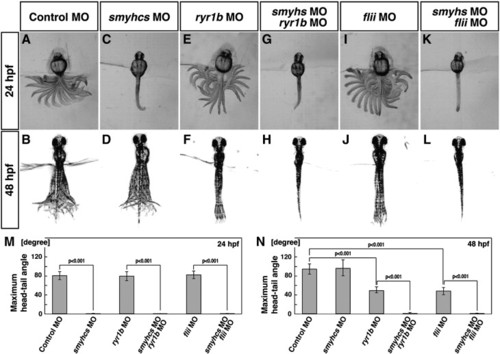Fig. 7
- ID
- ZDB-FIG-110812-29
- Publication
- Naganawa et al., 2011 - Developmental transition of touch response from slow muscle-mediated coilings to fast muscle-mediated burst swimming in zebrafish
- Other Figures
- All Figure Page
- Back to All Figure Page
|
Coilings and burst swimming are mediated by slow and fast muscles, respectively. (A–L) Superimposed movement of the trunk and tail. Control (A), ryr1b (E) and flii (I) morphants exhibited normal coilings at 24 hpf. smyhcs morphants (C), smyhcs-ryr1b (G) and smyhcs-flii (K) double morphants did not move in response to touch at 24 hpf. Control (B) and smyhcs (D) morphants showed normal burst swimming at 48 hpf. The burst swimming was compromised in ry1b (F) and flii (J) morphants at 48 hpf. smyhcs-ryr1b (H) and smyhcs-flii (L) double morphants did not move at 48 hpf. (M,N) Histograms showing the maximum head–tail angles at 24 hpf (M) and 48 hpf (N). |
| Fish: | |
|---|---|
| Knockdown Reagents: | |
| Observed In: | |
| Stage Range: | Prim-5 to Long-pec |
Reprinted from Developmental Biology, 355(2), Naganawa, Y., and Hirata, H., Developmental transition of touch response from slow muscle-mediated coilings to fast muscle-mediated burst swimming in zebrafish, 194-204, Copyright (2011) with permission from Elsevier. Full text @ Dev. Biol.

